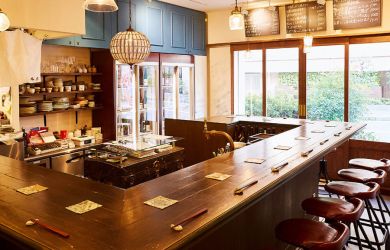
October 1, 2009
Tokyo Green Space
A bevy of local residents and organizations offer surprising visions for creating an urban forest
By Metropolis
Five-Sided Green

Courtesy of 5bai Midori

Courtesy of 5bai Midori
5bai Midori is a landscape company that brings the biodiversity of Japan’s countryside to the city via a “modular” native plant system. Its newest project was unveiled on October 1, when the Yamatane Museum, which focuses on post-Meiji Japanese paintings, re-opened in a new building clad in native plants.
The landscape architect behind 5bai Midori, Michio Tase, achieved worldwide fame for ACROS Fukuoka, a 15-story office building built in Kyushu in 1995. On the street side, the structure looks like an ordinary office tower, yet on the side facing a city park, it steeples down under cover of what looks like a lush rural hillside, in effect extending the park vertically and introducing dozens of plant species and a thriving ecosystem for birds and insects.
Like Suzuki’s firefly project, 5bai Midori aims to link city and country by revitalizing and extending the satoyama into urban areas—for instance, plants that are used in projects in Tokyo and Osaka are sourced within those regions. Because the system is modular, residential uses range from a single tray with grasses, shrubs and trees to an entire portable garden.
Tase’s philosophy is “Passive Architecture and Active Landscaping with Nature.” By creating natural habitats that support bees, insects and other animals, his landscapes grow when birds bring additional seeds into the garden.
5bai Midori: 3-33-3 Ebisu, Shibuya-ku. Tel 03-3280-2041. Nearest stn: Ebisu. By appointment only. www.5baimidori.com
Yamatane Museum: 3-12-36 Hiroo, Shibuya-ku. Tel: 03-5777-8600. Open Tue-Sun 10am-5pm, closed Mon. Admission ¥1,000 (adults); student discounts available. Nearest stn: Ebisu. www.yamatane-museum.or.jp/english/index.html
Suginami Green Curtain

Photo by Jared Braiterman
Located just west of Shinjuku, Suginami-ku is an innovator in environmental and garden projects. In addition to initiating one of Tokyo’s first residential compost programs, the ward created the world’s largest “green curtain” to shade the south wall of its assembly hall in Asagaya-Minami. Loofah, cucumber, gourd, and morning glory extend over 29 meters in height in summer and fall, lowering indoor temperatures by 4 degrees Celsius and cleaning the air outside.
Suginami’s giant green curtain has inspired local residents to create their own smaller versions, with bitter melon and morning glory particularly popular as covering vegetation. The ward also gained worldwide attention with Operation Flower, a crime-fighting project that fostered neighborhood interaction by distributing flowers and encouraging gardening. With a ¥6 million annual budget and over 800 residents participating, Operation Flower is credited with reducing the local robbery rate by 80 percent.
Suginami-ku assembly hall: 1-15-1 Asagaya-Minami. Tel: 03-3312-2111. Nearest stn: Minami-Asagaya. Can be viewed from the sidewalk late spring through fall.
Additional Reading
- Enbutsu, Sumiko. A Flower Lover’s Guide to Tokyo: 40 Walks for All Seasons. Kodansha, 2007.
- Miyazaki, Hayao. Totoro no sumu ie [The House Where Totoro Lives]. Tokyo: Asahi Shimbun-
sha, 1991.
About Tokyo Green Space
Tokyo Green Space is a public research project exploring new visions of the urban forest. The goal is to educate the general public, corporations and governments about how urban gardens contribute to worldwide development and environment solutions.
A fellowship from Hitachi and the Council on Foreign Relations supports Tokyo Green Space. Its founder, Jared Braiterman, PhD, is a Harvard- and Stanford-trained design anthropologist and a Research Fellow at the Tokyo University of Agriculture.
Ongoing research findings are documented on a free blog. Your comments and input are most welcome.
www.tokyogreenspace.wordpress.com
イメージ(俯瞰)_Deck-Nicknamed-T-DeckOverlooking-view-image-1-390x250.jpg)




